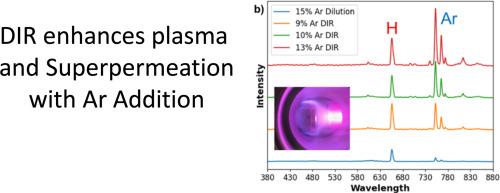在直接内部循环中,加入氩气对钯合金金属箔泵氢气超渗透的影响
IF 2
3区 工程技术
Q1 NUCLEAR SCIENCE & TECHNOLOGY
引用次数: 0
摘要
金属箔泵(MFPs)是一种用于从聚变装置的等离子体废气中直接内部回收氢同位素的领先技术。mfp依赖于超渗透的概念,等离子体产生的氢原子吸收到金属箔中,迅速扩散,并向下游解吸。迄今为止,对超渗透的研究主要使用纯氢,或者在某些情况下使用痕量杂质。在实践中,等离子体排气可以含有显著水平的等离子体增强气体,例如氩,一种具有亚稳态的惰性气体,可以增强等离子体。在这项工作中,我们系统地研究了Ar添加对PdCu和PdAg mfp在低温下性能的影响。性能在很大程度上取决于DIR分数。在可忽略的DIR水平下,添加Ar并没有显著改善通量比稀释效应。然而,在适当的DIR操作下,相对于纯H2,通量提高了90%,最佳浓度范围是5 - 10%的Ar排出系统。添加量超过15%后,血浆增强效应被稀释所抵消。性能与原子H发射相关,PdAg比PdCu的优势更明显。在显著DIR水平下运行会显著改变流动动力学,导致MFP附近的浓度梯度,创造促进H2解离的等离子体条件。本文章由计算机程序翻译,如有差异,请以英文原文为准。

The impact of argon addition on hydrogen superpermeation through palladium alloy metal foil pumps during direct internal recycling
Metal foil pumps (MFPs) are a leading technology for the direct internal recycling (DIR) of hydrogen isotopes from the plasma exhaust of fusion devices. MFPs rely on the concept of superpermeation, where plasma-generated atomic hydrogen absorbs into the metal foil, rapidly diffuses, and desorbs downstream. To date, studies of superpermeation have predominantly employed pure hydrogen or in some cases trace levels of impurities. In practice the plasma exhaust may contain significant levels of plasma enhancement gases such as argon, an inert gas with metastable states that can enhance the plasma. In this work, we systematically study the impact of Ar addition on the performance of PdCu and PdAg MFPs at low temperature. Performance was strongly dependent on the DIR fraction. At negligible DIR levels Ar addition did not significantly improve the flux over dilution effects. However, under appreciable DIR operation the flux was enhanced up to 90 % relative to pure H2, with the optimal concentration range being 5–10 % Ar exiting the system. Beyond 15 % addition plasma enhancement benefits were offset by dilution. Performance correlated with the atomic H emission, and benefits were more pronounced for PdAg than PdCu. Operation at significant DIR levels dramatically alters the flow dynamics resulting in concentration gradients near the MFP, creating plasma conditions that promote H2 dissociation.
求助全文
通过发布文献求助,成功后即可免费获取论文全文。
去求助
来源期刊

Fusion Engineering and Design
工程技术-核科学技术
CiteScore
3.50
自引率
23.50%
发文量
275
审稿时长
3.8 months
期刊介绍:
The journal accepts papers about experiments (both plasma and technology), theory, models, methods, and designs in areas relating to technology, engineering, and applied science aspects of magnetic and inertial fusion energy. Specific areas of interest include: MFE and IFE design studies for experiments and reactors; fusion nuclear technologies and materials, including blankets and shields; analysis of reactor plasmas; plasma heating, fuelling, and vacuum systems; drivers, targets, and special technologies for IFE, controls and diagnostics; fuel cycle analysis and tritium reprocessing and handling; operations and remote maintenance of reactors; safety, decommissioning, and waste management; economic and environmental analysis of components and systems.
 求助内容:
求助内容: 应助结果提醒方式:
应助结果提醒方式:


